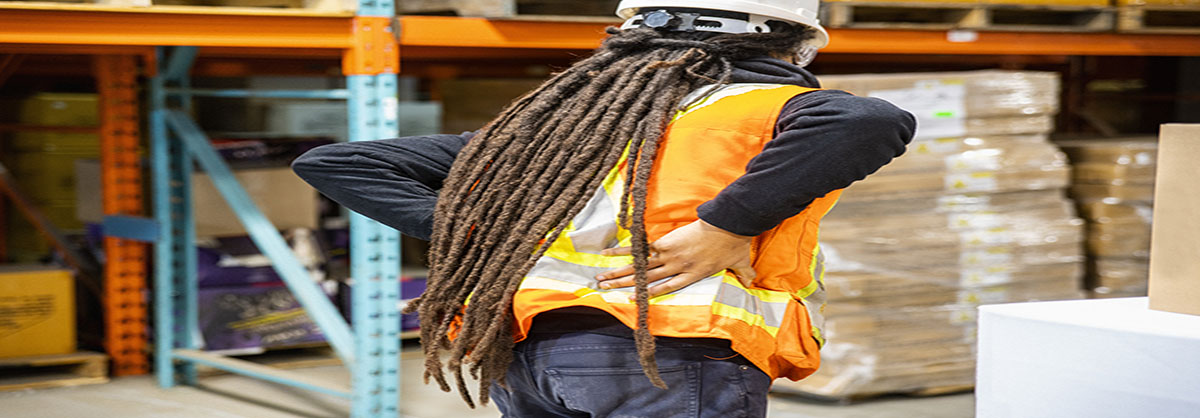
You work hard to provide for your family. Day in and day out, you give consistent effort and are diligent. Unfortunately, overexertion injuries can sideline you from earning a living, even if you are a safe and conscientious employee.
Overexertion injuries are a leading cause of workplace injury. According to the 2020 Liberty Mutual workplace safety index, heavy lifting cost U.S. employers nearly $14 billion per year. Overexertion is one of the leading causes of injury for all age groups and can happen in various workplace settings. From the office to the warehouse, it can be easy to overexert yourself to keep up with a fast-paced work environment.
Let’s dive into overexertion injuries, overexertion injury prevention and what to do if you suffer an overexertion injury.
What Is an Overexertion Injury?
An overexertion injury is a bodily injury that is the result of a work-related action or movement. Many times, overexertion is caused by:
- Excessive lifting or moving objects
- Repetitive motion
- Awkward posture or positioning to complete a task
- Sitting or standing for long periods
- Use of force to complete a task
- Completing physical labor without the proper equipment
Overexertion injuries can affect the entire body from the head and neck down to your feet. The most common examples of overexertion injuries are strains, sprains, tears and other soft-tissue injuries.
Overexertion can affect large areas of your body, like your back or legs. They can also involve more specific locations, like your fingers and wrists, after hours of fine-motor activity. Carpal tunnel syndrome is a common wrist injury that occurs when a worker has to type for long periods without rest and ergonomic equipment.
Overexertion Injury Prevention
While overexertion injuries are common amongst the United States workforce, they are preventable with the right amount of support and buy-in from employers and employees.
In an Occupational Health & Safety (OHS) Magazine article entitled “3 B’s for Preventing Soft-Tissue Injuries,” author Robert Pater speaks to the number of signs, videos and other material he has seen urging employees to be careful. However, this mindset puts an unfair amount of responsibility on the workers. Employers must provide equipment and training that set up workers for injury prevention.
While the skills required to avoid these injuries may be different for each job, here are some general tips to prevent an overexertion injury:
- Use proper lifting techniques. Your employer should provide proper training for appropriate lifting techniques to help avoid injury – and you should practice them.
- Ask for help if you think a lift or job might be too strenuous. It is better to be safe than sorry.
- Use the right tools for the job. Makeshift tools and techniques can easily cause injury and could also place the liability of an injury on you.
- Use ergonomic equipment and workspaces. If you don’t currently have ergonomic equipment, ask your employer about implementing it into your workplace. From ergonomic lifting equipment to prevent back injuries to ergonomic keyboards to prevent carpal tunnel, having the right equipment can substantially impact your workplace safety.
- Take breaks to give your body time to recover. Repetitive motion is one of the top causes of overexertion injuries. Taking breaks is a practical and simple form of prevention.
What to Do If You Suffer an Overexertion Injury
While you try your best to follow the correct procedures, use the right equipment for the job and stay safe while at work, you can still end up suffering an overexertion injury. Here’s what you need to do if you are injured:
- Inform your supervisor or human resources director of your injury. Informing your supervisor or other need-to-know employees as quickly as possible is the best route to keeping your claim airtight. If you wait or try to tough it out, you may end up worsening your injury and leave more space for the insurance adjuster to dispute your claim.
- Seek medical attention. After you have informed your employer or supervisor, request that they send you to a medical care specialist who can assess and diagnose your injury. Under most circumstances, a workers’ compensation insurance company does not have to pay for your medical care unless they pre-authorize the medical provider that you see. If the employer or workers’ compensation insurer is unwilling to send you for medical treatment, contact a qualified workers’ compensation lawyer to help resolve that issue.
- Consult with an experienced workers’ compensation lawyer before you accept compensation. A skilled workers’ comp lawyer will be able to assess your case and make sure you are getting fair payment for your injury.
Have you suffered an overexertion injury while on the job? Contact the legal experts at Eng and Woods today to see how we can help you get the compensation you deserve.
By
Eng & Woods
|
Published
November 3, 2020
|
Posted in
Victoria Addington
You made a good point when you discussed that your employer should send you to a medical care specialist. My friend is looking for a workers comp attorney. I should advise him to choose one with high success rates.
Tran Leachman
Hey Blog Owner. My head was constantly nodding while reading your blog post. Your ability to capture the essence of the subject matter and express it with such cleverness and clarity is absolutely astonishing.
Toby Guckes
I just wanted to share my admiration for the aesthetically pleasing design of your blog. It’s refreshing to come across a website that combines aesthetics with knowledgeable articles. You’ve truly created a great balance!